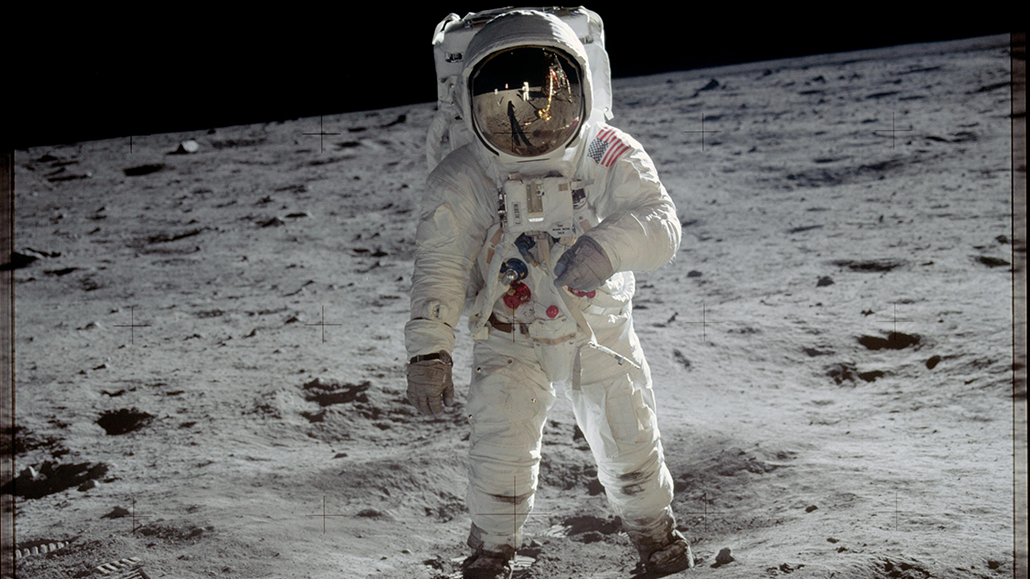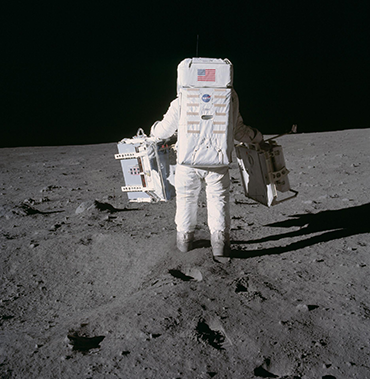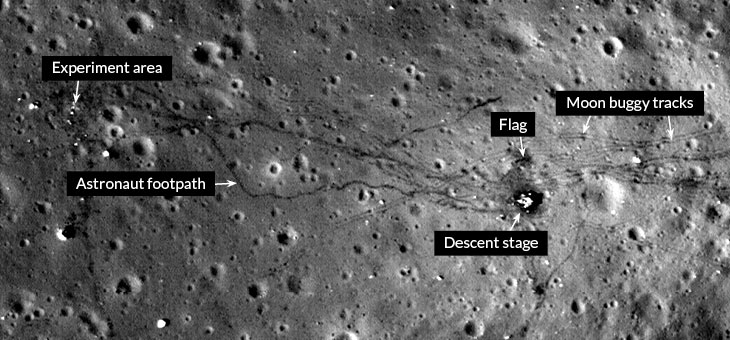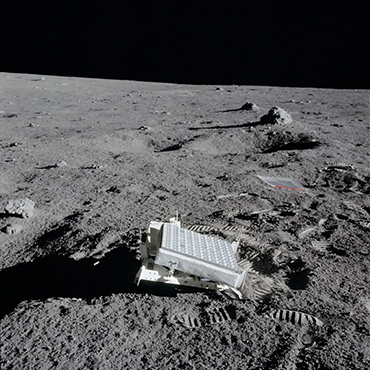Learning from what Apollo astronauts left on the moon
Fifty years ago, astronauts left more than footprints on Earth’s lunar neighbor

This photo, taken in 1969 by Astronaut Neil Armstrong, shows Astronaut Buzz Aldrin walking on the moon during the Apollo 11 mission. Apollo astronauts left a lot on the moon’s surface, from scientific instruments to trash.
NASA
Science News for Students is celebrating the 50th anniversary of the moon landing, which passed in July, with a three-part series about Earth’s moon. In part one, Science News reporter Lisa Grossman visited rocks brought back from the moon. Part two explores what astronauts left on the moon. Look for part three in November, and check out our archives for this story about Neil Armstrong and his pioneering 1969 moonwalk.
Fifty years ago, astronauts first walked on the moon. Part of NASA’s Apollo program, they kicked off six missions to visit Earth’s lunar neighbor. Once on the moon, Apollo astronauts had two main goals: Get themselves and the moon rocks they gathered home safely.

That meant making space on cramped lunar modules for around 360 kilograms (about 800 pounds) of moon samples. Anything they didn’t need for the ride home got tossed — cameras, hammocks, boots and trash. They even ditched big stuff like moon buggies and launchpads.
But the astronauts left more than trashed castoffs. The crews marked their visits with six American flags and plenty of keepsakes. They also left behind about a dozen experiments to keep tabs on the moon. One still runs today.
These experiments were important parts of Apollo, says Noah Petro. He is based at NASA’s Goddard Space Flight Center in Greenbelt, Md. There he works as a project scientist for the Lunar Reconnaissance Orbiter mission. Its aim has been to map the moon.
Back in the Apollo era, the experiments didn’t get much attention, Petro notes. That’s because the big story was sending humans to the lunar surface.
When we think of Apollo’s 50-year legacy, most of us aren’t picturing astronaut junk gathering space dust. But nations are planning new ventures to the moon. So researchers are now thinking about how to prevent future lunar visitors from erasing the marks of humans’ first footsteps beyond Earth.
Setting up a lunar lab
The six moon missions ran from 1969 to 1972. Apollo crews spent a total of nearly 80 hours exploring the lunar surface. They gathered rocks, took photos of the moon’s surface and did many types of experiments. Astronauts caught particles of the solar wind with metal foil. They even set off explosives to measure the resulting tremors.
The first mission to the moon, Apollo 11, planted solar-powered seismometers. These devices detect and measure moonquakes — tremors that pass through the moon. The astronauts also left behind mirrors. When paired with lasers on Earth, the mirrors can be used to precisely measure the distance between Earth and the moon.
Astronauts left more elaborate setups during other Apollo missions. Some of the nuclear-powered devices collected data through 1977. As NASA decided to focus on other projects, it pulled the plug on the whole operation.
The data sat unstudied for years, Petro says. But within the last decade, a new generation of scientists has taken up the torch. They are analyzing Apollo observations to answer some lingering questions.
Solving old mysteries
This task isn’t as simple as picking up where 1970s scientists left off. That’s what Seiichi Nagihara discovered. A geophysicist at Texas Tech University in Lubbock, he set out to solve a decades-old puzzle about the moon’s temperature.
On Apollo 15 and 17, astronauts installed thermometers in the lunar surface. These took the moon’s temperature at various depths and sent those data back to Earth. Apollo-era scientists reviewed data collected through 1974. The results showed something odd. The moon’s temperature just beneath the surface was slowly rising.

“We’re talking about very minor warming,” just a couple of degrees, says Nagihara. But researchers at the time couldn’t figure out why it was happening. So Nagihara decided to examine all the temperature data collected through 1977. Sadly, the tapes that recorded these measurements were missing. This is a common problem. During the Apollo era, data were housed at the individual labs of scientists. Many measurements were never properly archived.
“A group of us decided to … try to hunt down the tapes,” Nagihara says. They scoured thousands of documents at NASA’s Johnson Space Flight Center in Houston, Texas. The researchers tracked down 440 tapes held in an archive in Maryland. But those covered only about three months of observations.
Luckily, Nagihara’s team discovered weekly memos that noted more temperature data. These had been archived at the Lunar and Planetary Institute in Houston. The team used these data to piece together a picture of the moon’s temperature from 1971 through 1977.
The surface was still slowly warming when data collection ended. In search of a heat source, the researchers turned to pictures taken by the Lunar Reconnaissance Orbiter.
This spacecraft has been orbiting the moon since 2009. Its images showed that soil stirred up by astronauts was slightly darker than other lunar terrain. Perhaps it was dark enough to absorb more sunlight and warm the ground below.
Computer models would confirm that the moon wasn’t heating up from the inside out.
Astronauts trekking around the moon’s surface probably caused it to heat up by about 2 to 3 degrees Celsius (about 4.5 to 5.5 degrees Fahrenheit). And the extra heat slowly spread more than a meter (3 feet) into the ground. That caused the warming detected by Apollo instruments. Turns out those footsteps had left marks on the moon far deeper than those iconic boot prints.
The researchers reported the findings in April 2018 in the Journal of Geophysical Research: Planets.
Keeping vigil over gravity
Nagihara and other researchers dig up and analyze old Apollo data. But one lone project is still in full swing: a laser “yardstick” to measure the distance between Earth and the moon.

It’s called the laser ranging retroreflector experiment. It relies on those special mirrors that astronauts placed on the moon by astronauts on the Apollo 11, 14 and 15 missions. Each mirror has three sides, shaped like a cube’s corner. When light hits the corner, it will always reflect in the exact direction from which it came. Researchers shoot a laser beam at these mirrors from a telescope on Earth. They then clock the time it takes for the light to return.
These measurements have offered several insights. For instance, they showed the moon is moving away from Earth at about 3.8 centimeters (1.5 inches) per year. And slight variations in the moon’s rotation suggest that this body has a relatively small core.
Physicist Tom Murphy is using the mirrors to answer a question much bigger than the moon. He’s testing the equivalence principle — a key part of Einstein’s theory of gravity.
That equivalence principle states that any two objects in the same field of gravity should fall at the same rate. A bowling ball and a ping-pong ball should hit the ground at the same time (at least if they fall in a vacuum). And the Earth and moon should orbit around the sun at exactly the same rate. If the orbital rate breaks with this principle, that would reveal a flaw in the theory.
Einstein’s theory doesn’t mesh with quantum mechanics. That’s the physics of very small objects. Something has to give. This principle might be one of those things, says Murphy, at the University of California, San Diego. If scientists manage to prove Einstein wrong, it could lead to a new theory that unites his with quantum mechanics.
So far, the Earth and moon orbit the sun at the same rate. But in 2006, Murphy started collecting data with more precision. It will take years more to get enough data and better computer models to analyze it, Murphy says. Luckily, the mirrors on the moon don’t require any power, so he can collect data into the foreseeable future. Eventually, those fine-scale observations could reveal a crack in the principle.
One astronaut’s trash
About a dozen types of instruments were installed on the moon. Some measured its magnetic field. Others sniffed out the chemical makeup of its fragile atmosphere. NASA’s Lunar Data Project is restoring data from these and other Apollo experiments. That way, scientists can continue to pore over the observations for years to come.
“When you have this incredibly rare resource, you can’t not keep working on it,” says planetary scientist Renee Weber. She studies lunar seismic data at NASA’s Marshall Space Flight Center in Huntsville, Ala. “There are always new techniques to try” and better computers to tease out missed signals.
Moonquakes sensed by Apollo seismometers hint that the moon may still be tectonically active. And young faults on the lunar surface support this idea, Weber’s team reported in May. Understanding moonquakes could help NASA and other agencies decide where to land future spacecraft, Weber says. Or where to construct buildings on the moon. If these young faults mark sites of ground-shaking activity, future lunar visitors may want to avoid them, she says.
There’s also plenty to learn by testing how well the Apollo instruments and astronaut leftovers have held up. All of that stuff has been exposed to the lunar elements for decades. Future missions could sample the debris to get a sense of how human communities might one day fare on the moon.
Everything at these sites is priceless to research, says planetary scientist Philip Metzger. He works at the University of Central Florida in Orlando. He imagines probing the effects of radiation and solar wind on things like batteries, camera lenses, towels and earplugs.
There’s even value in bags of astronauts’ poop. Studies show microbes can last in space over very short timescales, Metzger says. Scientists could test whether microbes in astronaut waste have survived or mutated over the past 50 years. That could help determine whether life could hop between planets or even solar systems. These are “really important questions,” he says, “about the position of life in the cosmos.”







